| View previous topic :: View next topic |
| Author |
Message |
Peter Megaw
Site Admin

Joined: 13 Jan 2007
Posts: 966
Location: Tucson, Arizona



|
 Posted: Feb 07, 2014 11:31 Post subject: Daylight Fluorescent Hyalite Opal from Mexico Posted: Feb 07, 2014 11:31 Post subject: Daylight Fluorescent Hyalite Opal from Mexico |
|
|
I picked up some interesting new material here at Tucson the other day
it is Hyalite opal from somewhere (Jalisco?) in central Mexico that shows what appears to be daylight fluorescence
Indoors under fluorescent or incandescent light it has almost no color at all (picture 1) but in daylight it has an attractive "'uranyl" yellow-green color (picture 2) similar to, but not as intense as the strong color it shows under Short-Wave UV (picture 3).
I have heard of similar material from Erongo? but not seen it.
The best pieces of this material is completely transparent with smooth botryoidal surfaces and small free-standing druplets.
Hopefully we will be able to get more complete location information someday
| Description: |
Hyalite Opal
Central Mexico
5 cm
Incandescent light |
|
| Viewed: |
65584 Time(s) |
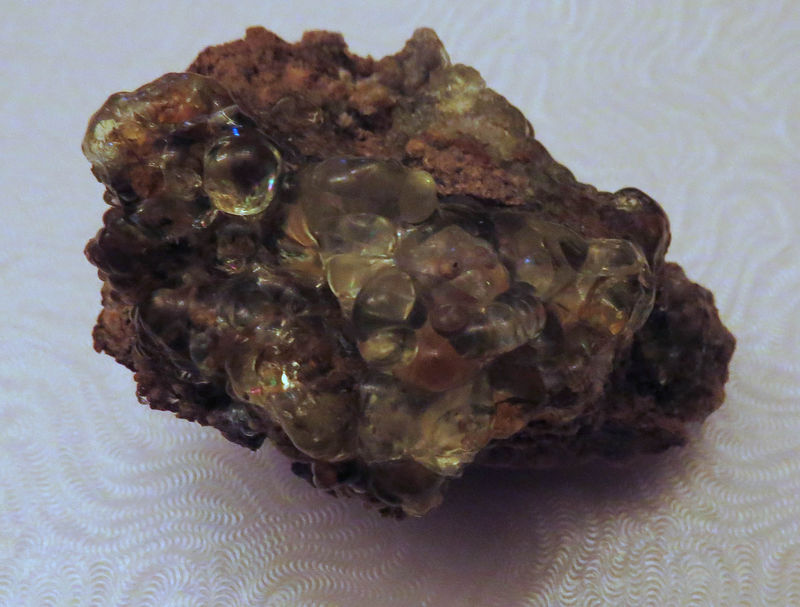
|
| Description: |
Hyalite Opal
Central Mexico
5 cm
daylight (but not direct sun) |
|
| Viewed: |
65583 Time(s) |
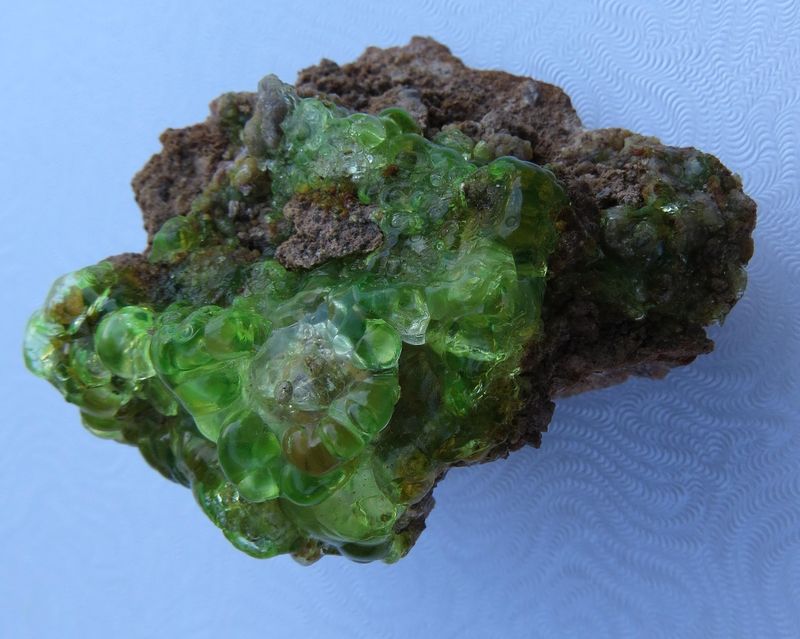
|
| Description: |
Hyalite Opal
Central Mexico
5 cm
SW Ultraviolet (not in dark) |
|
| Viewed: |
65493 Time(s) |
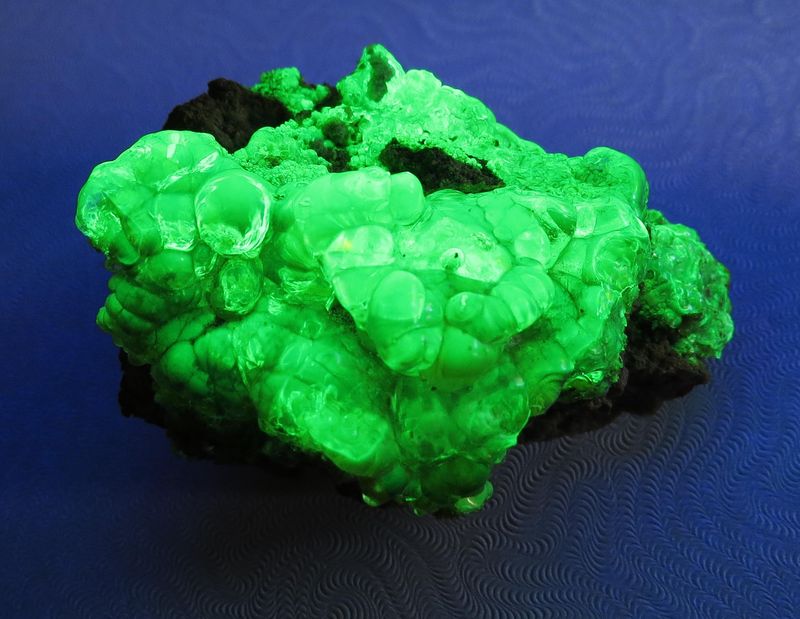
|
_________________
Siempre Adelante! |
|
| Back to top |
|
 |
Mark Ost

Joined: 18 Mar 2013
Posts: 516
Location: Virginia Beach



|
 Posted: Feb 07, 2014 17:41 Post subject: Re: Daylight Fluorescent Hyalite Opal from Mexico Posted: Feb 07, 2014 17:41 Post subject: Re: Daylight Fluorescent Hyalite Opal from Mexico |
|
|
| That is remarkable considering that the vast majority of fluorescence is so low level as to be totally undetectable in daylight. A very interesting piece Pete.
|
|
| Back to top |
|
 |
waterdog
Joined: 31 Dec 2012
Posts: 10


|
 Posted: Feb 07, 2014 17:56 Post subject: Re: Daylight Fluorescent Hyalite Opal from Mexico Posted: Feb 07, 2014 17:56 Post subject: Re: Daylight Fluorescent Hyalite Opal from Mexico |
|
|
Peter,
Would you care to share the name/location of the dealer? I'd like to see that in person.
|
|
| Back to top |
|
 |
Susan Robinson
Joined: 05 Aug 2010
Posts: 163
Location: Hancock, MI


|
 Posted: Feb 07, 2014 19:12 Post subject: Re: Daylight Fluorescent Hyalite Opal from Mexico Posted: Feb 07, 2014 19:12 Post subject: Re: Daylight Fluorescent Hyalite Opal from Mexico |
|
|
My husband says that without analysis, there may be enough ultraviolet radiation in sunlight to cause the mineral to fluoresce. A similar effect can be seen in some of the green fluorites from England (particularly the green ones from the Heights mine). In the case of hyalite opal, the activator is thought to be the uranyl ion.
_________________
Susan Robinson |
|
| Back to top |
|
 |
cascaillou
Joined: 27 Nov 2011
Posts: 257


|
 Posted: Feb 07, 2014 19:31 Post subject: Re: Daylight Fluorescent Hyalite Opal from Mexico Posted: Feb 07, 2014 19:31 Post subject: Re: Daylight Fluorescent Hyalite Opal from Mexico |
|
|
A similar phenomenom is seen in "green transmitter" (aka "chartreuse") diamonds, which show intense green luminescence under visible excitation (thus green emitter would be a better terminology for such diamonds), so that they look yellowish green or greenish yellow under fluorescent light (that includes daylight), while they will look yellowish brown under incandescent light.
Very interesting opal indeed. That is exactly the kind of specimen I was refering to as 'scientifically eloquent' in the discussion about "what defines a mineral quality", as the phenomenom definately adds great interest to the piece. But maybe I'm just one more rock nerd hahaha
|
|
| Back to top |
|
 |
Pierre Joubert
Joined: 09 Mar 2012
Posts: 1605
Location: Western Cape



|
 Posted: Feb 08, 2014 02:29 Post subject: Re: Daylight Fluorescent Hyalite Opal from Mexico Posted: Feb 08, 2014 02:29 Post subject: Re: Daylight Fluorescent Hyalite Opal from Mexico |
|
|
Here is a specimen from Erongo, Namibia. The photos where also taken in sunlight. I thought that the green colour was due to some mineral. Please help me right.
| Description: |
Hyalite Opal
Erongo mountains; Namibia
hand for size |
|
| Viewed: |
65053 Time(s) |
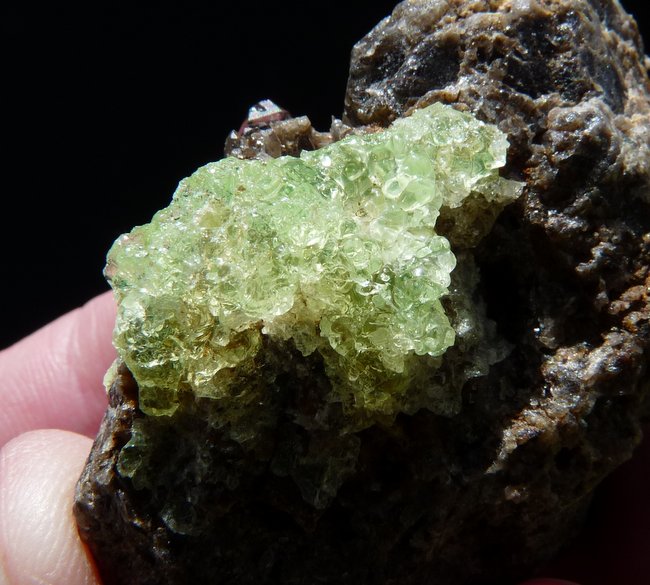
|
| Description: |
Hyalite Opal
Erongo mountains; Namibia
hand for size |
|
| Viewed: |
65175 Time(s) |
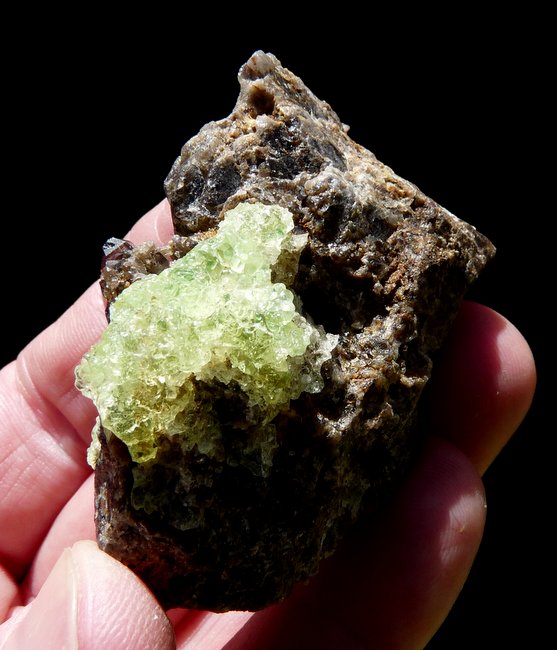
|
_________________
Pierre Joubert
'The tree of silence bears the fruit of peace. ' |
|
| Back to top |
|
 |
Peter Megaw
Site Admin

Joined: 13 Jan 2007
Posts: 966
Location: Tucson, Arizona



|
 Posted: Feb 19, 2014 09:13 Post subject: Re: Daylight Fluorescent Hyalite Opal from Mexico Posted: Feb 19, 2014 09:13 Post subject: Re: Daylight Fluorescent Hyalite Opal from Mexico |
|
|
Pierre, several people mentioned the Erongo material to me during Tucson...thanks for posting pictures. Is the fluorescence strongest in direct sunlight or indirect? The Mexican material seems to wash out in direct sunlight, with the strongest response in shade or "filtered" sunlight. Glass clearly dampens the effect.
Having obtained more material since my initial post, I can make more observations.
1. There is a range of daylight response from almost none to a pale yellow to the intense yellow-green shown here.
2. There appears to be no correlation between thickness of opal and fluorescence
3. SWUV response is much greener in the daylight fluorescing material. The less responsive material gives off a yellower fluorescence under SWUV.
4. LWUV response is also strong, but I don't have a good LW light so I can't make systematic observations.
5. A few pieces have opal grown over sprays of yellow acicular crystals that look like sklowdowskite. In one instance the opal overgrows individual fibers giving an effect that looks like a sea anemone.
6. Despite the obvious uranyl activator, the material gives off little radiation (<0.3 mrg/min indicated by a hand-held detector)
_________________
Siempre Adelante! |
|
| Back to top |
|
 |
Gerhard Niklasch
Joined: 27 Mar 2009
Posts: 134
Location: Munich



|
 Posted: Feb 19, 2014 09:59 Post subject: Re: Daylight Fluorescent Hyalite Opal from Mexico Posted: Feb 19, 2014 09:59 Post subject: Re: Daylight Fluorescent Hyalite Opal from Mexico |
|
|
Looking forward to seeing a specimen in person (fortunately there are good sources :) )…
Let me encourage anyone in possession of one, and of a gem spectroscope and a not too cloudy sky, to aim the second at the first under the third! The UO2 group produces a very characteristic response, with three narrow emission bands side by side in the green, flanked by two weaker ones, one on the yellow side and one on the blue-green side, like the fingers of a hand. The spectrum looks very different from other bright-green fluorescent minerals such as Franklin Willemite or MSH Genthelvite, whose response comes in a single wide green band.
| Quote: |
2. There appears to be no correlation between thickness of opal and fluorescence
|
This is what I would expect when the concentration of activator sites is high enough to absorb (and convert) all the incoming UV already very close to the surface.
Enjoy,
Gerhard
|
|
| Back to top |
|
 |
Pierre Joubert
Joined: 09 Mar 2012
Posts: 1605
Location: Western Cape



|
 Posted: Feb 19, 2014 10:24 Post subject: Re: Daylight Fluorescent Hyalite Opal from Mexico Posted: Feb 19, 2014 10:24 Post subject: Re: Daylight Fluorescent Hyalite Opal from Mexico |
|
|
| Peter Megaw wrote: | | Pierre, several people mentioned the Erongo material to me during Tucson...thanks for posting pictures. Is the fluorescence strongest in direct sunlight or indirect? |
Hi Peter. I am still not sure whether it fluoresces or whether it is coloured green by some or other mineral. I find it strange that the real colour is a beautiful green 'jelly' colour but on photos the colour appears more pale green. Here follows 2 more photos; one taken outside with cloud covering and one inside, with daylight (overcast) coming through the window. Compare these photos with the original ones taken in sunlight.
| Description: |
Hyalite Opal
Erongo mountains; Namibia
same as above
This photo was taken under an overcast sky. |
|
| Viewed: |
64386 Time(s) |
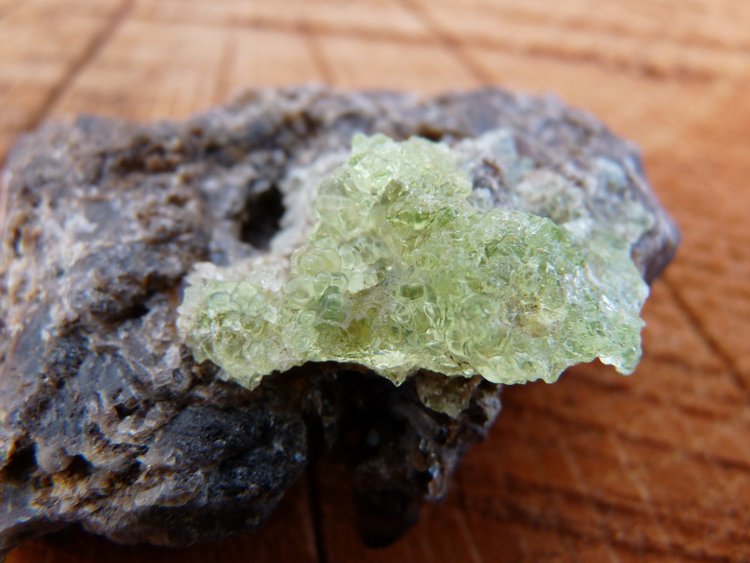
|
| Description: |
Hyalite Opal
Erongo mountains; Namibia
same as above.
This photo was taken inside, with light coming in through the window. (overcast sky) The real colour is darker and more uniform than this. |
|
| Viewed: |
64384 Time(s) |
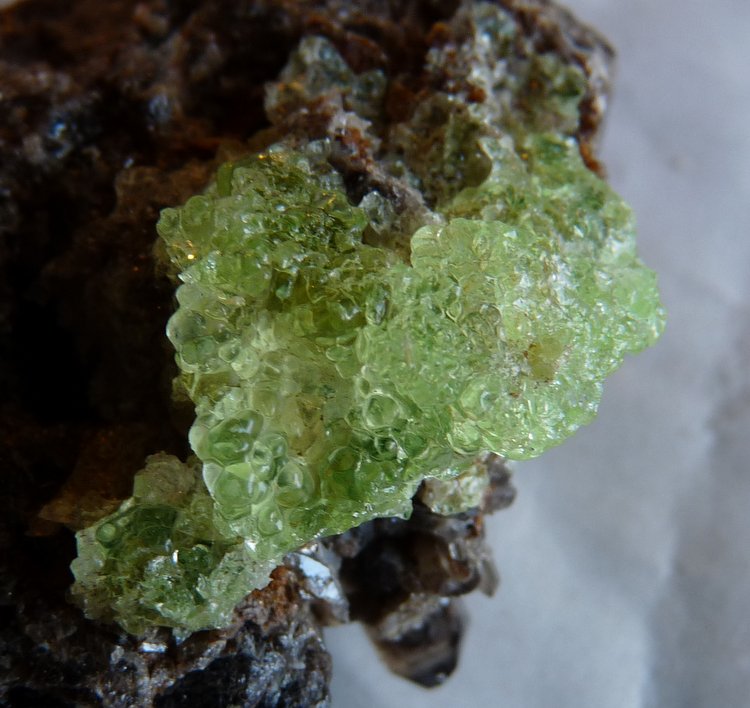
|
_________________
Pierre Joubert
'The tree of silence bears the fruit of peace. ' |
|
| Back to top |
|
 |
alfredo
Site Admin

Joined: 30 Jan 2008
Posts: 986



|
 Posted: Feb 19, 2014 11:04 Post subject: Re: Daylight Fluorescent Hyalite Opal from Mexico Posted: Feb 19, 2014 11:04 Post subject: Re: Daylight Fluorescent Hyalite Opal from Mexico |
|
|
"Daylight fluorescence" is a more widespread phenomenon than mineral collectors realize, but is usually overlooked. Several minerals fluoresce when exposed to the shorter wavelengths of visible light (blue and violet). The best way to observe it is to look at minerals illuminated exclusively with blue light, no other wavelengths of illumination being present. Then if your mineral glows in green, yellow or red, you are observing fluorescence and not just reflection of daylight.
A century ago someone tried this by blacking out the windows in a room, leaving only one small open spot for a beam of sunlight to enter, which was then filtered through a glass jar of copper sulphate solution. Nowadays it is easier (but more dangerous) to just use a blue laser at night. You will find several yellow secondary uranium minerals fluoresce under blue light, some diamonds, rubies, red spinel, calcites, organic minerals.... and probably more that no one has thought to try yet.
|
|
| Back to top |
|
 |
Jordi Fabre
Overall coordinator of the Forum

Joined: 07 Aug 2006
Posts: 4930
Location: Barcelona



|
 Posted: Feb 24, 2014 10:36 Post subject: Daylight Fluorescent Hyalite Opal from Mexico - Analytic results Posted: Feb 24, 2014 10:36 Post subject: Daylight Fluorescent Hyalite Opal from Mexico - Analytic results |
|
|
César Menor Salván is a former researcher from the main Spanish scientific research center (CSIC) and we are enough lucky in Spain to have him as an analyzer through his company GeoSpectra. You can check APXS: from Mars to the mineral collector's workbench - (17) to know more about the analytic methods he is using.
Of course I submitted to him one of these fascinating new Mexican Opals and here you have a result of his studies. Interesting, right?
| Description: |
|
| Viewed: |
64230 Time(s) |
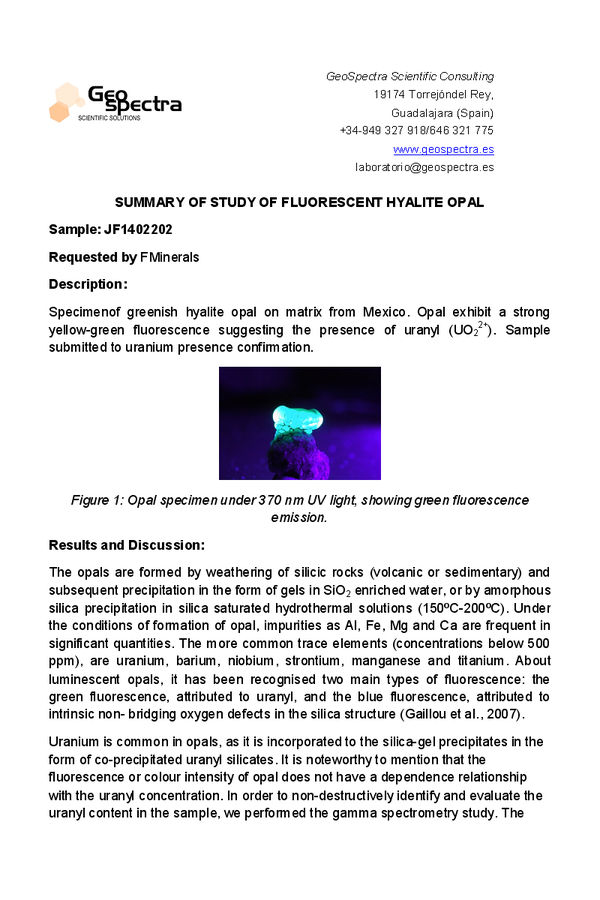
|
| Description: |
|
| Viewed: |
64125 Time(s) |
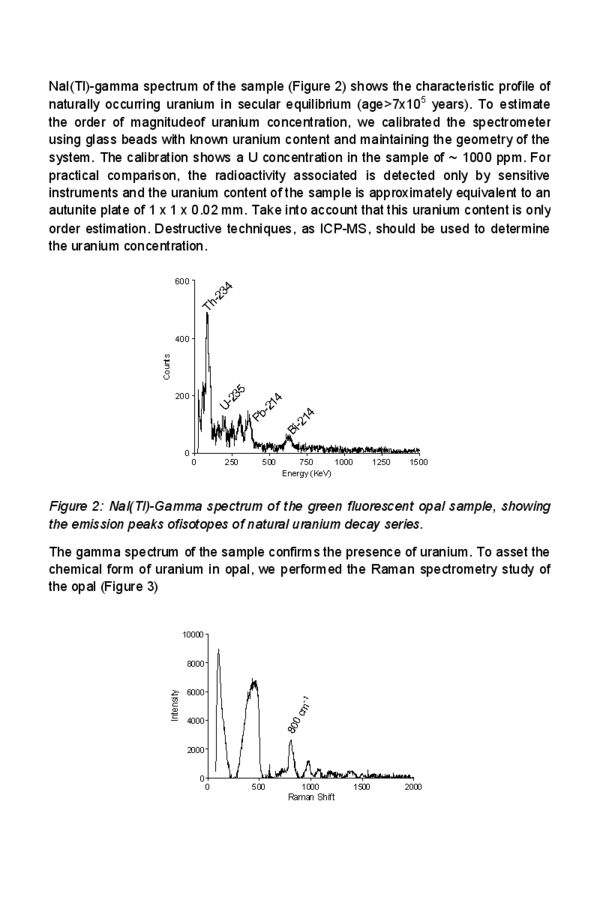
|
| Description: |
|
| Viewed: |
64208 Time(s) |
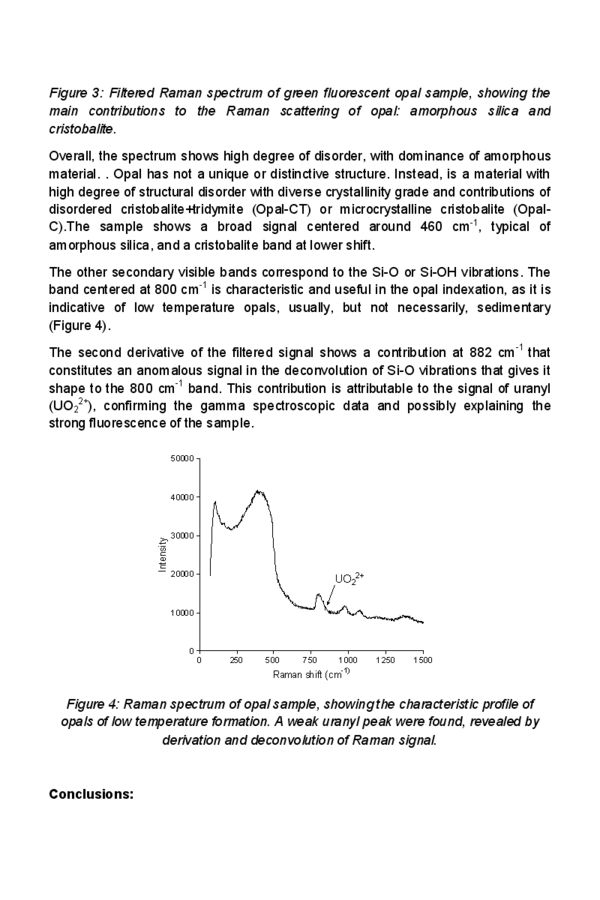
|
| Description: |
|
| Viewed: |
64234 Time(s) |
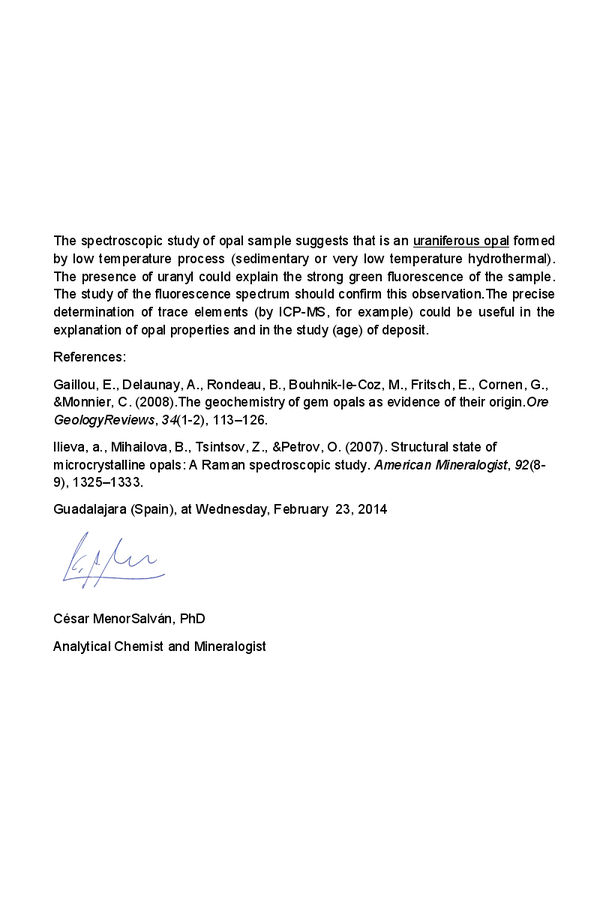
|
|
|
| Back to top |
|
 |
Don Lum

Joined: 03 Sep 2012
Posts: 2897
Location: Arkansas



|
 Posted: Feb 24, 2014 10:49 Post subject: Re: Daylight Fluorescent Hyalite Opal from Mexico Posted: Feb 24, 2014 10:49 Post subject: Re: Daylight Fluorescent Hyalite Opal from Mexico |
|
|
Jordi,
This is very interesting information. Thank you for the analysis.
Don
_________________
hogwild |
|
| Back to top |
|
 |
Gerhard Niklasch
Joined: 27 Mar 2009
Posts: 134
Location: Munich



|
 Posted: Feb 24, 2014 12:17 Post subject: Re: Daylight Fluorescent Hyalite Opal from Mexico Posted: Feb 24, 2014 12:17 Post subject: Re: Daylight Fluorescent Hyalite Opal from Mexico |
|
|
Indeed!
To put the quantitative results in perspective: What was the size of the sample, not counting the matrix? And what are the y-axis units on the gamma spectrogram - "Counts", but accumulated over what length of time?
Cheers, Gerhard
|
|
| Back to top |
|
 |
Mark Ost

Joined: 18 Mar 2013
Posts: 516
Location: Virginia Beach



|
 Posted: Feb 24, 2014 19:37 Post subject: Re: Daylight Fluorescent Hyalite Opal from Mexico Posted: Feb 24, 2014 19:37 Post subject: Re: Daylight Fluorescent Hyalite Opal from Mexico |
|
|
| Thank you Jordi for the analysis. This will be a nice compliment to the owners of those samples.
|
|
| Back to top |
|
 |
Cesar M. Salvan
Site Admin
Joined: 09 Jun 2008
Posts: 126
Location: Alcalá de Henares



|
 Posted: Feb 24, 2014 20:16 Post subject: Re: Daylight Fluorescent Hyalite Opal from Mexico Posted: Feb 24, 2014 20:16 Post subject: Re: Daylight Fluorescent Hyalite Opal from Mexico |
|
|
Thank you, Jordi, for the reference and friendship.
Gerhard, take into account that this is a summary. My policy is that all data and technical details belong to the owner of the samples :).
In this case, the sample weight is 2,53 g and the gamma spectrum accumulates during 4 hours, measured without matrix, in a background isolated "lead castle".
In spectrometry, the geometry of the system is a critical factor anyway. But, anyway, as you can see, the radioactivity is very low.
|
|
| Back to top |
|
 |
Gerhard Niklasch
Joined: 27 Mar 2009
Posts: 134
Location: Munich



|
 Posted: Feb 25, 2014 02:49 Post subject: Re: Daylight Fluorescent Hyalite Opal from Mexico Posted: Feb 25, 2014 02:49 Post subject: Re: Daylight Fluorescent Hyalite Opal from Mexico |
|
|
Thank you much for the clarification - yes, now the point is clear! It would have been something else if a 50µg sample had rivaled 60µg of Autunite. ;)
I'll soon have a chance to look at the luminescent response through my spectroscope, and will report on what I see. Unfortunately I have no way of capturing this photographically.
Cheers, Gerhard
|
|
| Back to top |
|
 |
Gerhard Niklasch
Joined: 27 Mar 2009
Posts: 134
Location: Munich



|
 Posted: Mar 01, 2014 15:17 Post subject: Re: Daylight Fluorescent Hyalite Opal from Mexico Posted: Mar 01, 2014 15:17 Post subject: Re: Daylight Fluorescent Hyalite Opal from Mexico |
|
|
Pleased to report that a specimen was delivered to my door today, and was eagerly unwrapped! Even behind closed windows under completely overcast skies, it is all yellowish-green and greenish-yellow (in separate intercalating areas) contrasting nicely with the sandstone(?) matrix. A white LED lamp strengthens the effect. It turns bright green under LWUV, and brighter yet under SWUV (I needn't even bother to darken the room!), showing (as expected) the marked uranyl bands when viewed through the spectroscope. While either UV wavelength is capable of exciting all the bands up to the blue-green one, it seems the blue component of the cloud and glass filtered daylight mostly excites the two or three bands towards the lower-energy, yellow side of the spectrum, resulting in a yellower hue. (The variation in hue across the specimen area under daylight or LED light might be due to varying concentrations of some co-activator.)
Excitedly (me too! :) ),
Gerhard
|
|
| Back to top |
|
 |
Mark Ost

Joined: 18 Mar 2013
Posts: 516
Location: Virginia Beach



|
 Posted: Mar 01, 2014 18:28 Post subject: Re: Daylight Fluorescent Hyalite Opal from Mexico Posted: Mar 01, 2014 18:28 Post subject: Re: Daylight Fluorescent Hyalite Opal from Mexico |
|
|
| Look forward to getting mine. Now if all our fingers fall off due to the Uranium content..........................
|
|
| Back to top |
|
 |
Gerhard Niklasch
Joined: 27 Mar 2009
Posts: 134
Location: Munich



|
 Posted: Mar 02, 2014 15:45 Post subject: Re: Daylight Fluorescent Hyalite Opal from Mexico Posted: Mar 02, 2014 15:45 Post subject: Re: Daylight Fluorescent Hyalite Opal from Mexico |
|
|
Well, for a typical hand specimen of this material, we're talking about an order of magnitude of one U238 decay per second on average, plus the same rate from each of the unstable daughter isotopes along the decay chain (that's what "secular equilibrium" amounts to). This really is low activity. If I were to worry about my fingers, I'm more worried of cutting myself on a cooking utensil or pinching them in a door by sheer personal stupidity. :)
I've played around a bit more with my LED flashlight and found that the yellow and green patches move when I move the light source: so they don't arise from different material properties at all. Rather, the opal blobs act as little lenses, focusing the incoming light onto a few bright spots on the rear side where they contact the matrix - and these spots move as the angle of illumination changes. And then the blobs again act as loupes, showing magnified versions of the bright spots to the observer's eyes. They now appear yellow because the violet component of the incoming light has already been absorbed and turned into green fluorescence. Those bits of opal through which I'm not looking at such a bright spot appear green rather than yellow.
Along the way, I also learned that this particular LED flashlight emits practically no blue light… it contrives somehow to produce a continuous spectrum from red through yellow to green, then there's a gap, and then there's a violet band centered around 450-460nm; the whole arranged to fool a human eye into seeing white when there's no spectroscope in the light path.
Cheers, Gerhard
|
|
| Back to top |
|
 |
alfredo
Site Admin

Joined: 30 Jan 2008
Posts: 986



|
 Posted: Mar 02, 2014 16:20 Post subject: Re: Daylight Fluorescent Hyalite Opal from Mexico Posted: Mar 02, 2014 16:20 Post subject: Re: Daylight Fluorescent Hyalite Opal from Mexico |
|
|
| Azurite must look awful in that light ;((
|
|
| Back to top |
|
 |
|


